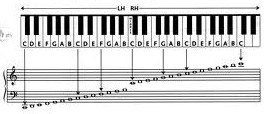The Grand Staff Explained
The grand staff is really a pretty cool invention because it allows you to read the treble clef and the bass clef at the same time. Yes, you heard me right. You read both clefs at once! This may seem impossible, but it really isn’t.
What Does The Grand Staff Include?
Take a look at the grand staff. You have the treble clef on top and the bass clef on the bottom. If you look at the beginning, or the left side, you will see a brace or bracket (it can be called either one) that connects the two clef signs and staves together. With this unique connection, you can see how high or low the notes will sound.

| ✅ The best self-study music theory book loved by all my readers and students. |
Remember that the notes in bass clef will sound low while the notes in treble clef will sound high. As the notes travel up both staves, they sound higher. As they travel from the treble clef down through the bass clef, they sound lower.
Can you see how the note names start at the bottom of the bass clef and work all the way up through the treble clef? There is a ledger line that connects a note in between the two staves. It is the same note used in both staves called middle C.
This note is considered one ledger line above bass clef and one ledger line below treble clef. It’s kind of cool how the same note in each clef is the point at which the notes join and cross from bass clef to treble clef.
So, who reads the grand staff anyways? Pianists do. The piano has a very large range of notes (88 to be exact) that needs both clefs to cover the amount of notes and sounds used.

When piano players read music, the right hand plays the treble clef part while the left hand plays the bass clef part. That is why you generally hear both low notes and high notes at the same time when someone is playing the piano. It’s almost like magic!
Now, you know how pianists are able to read music using both low and high sounds together. It’s not really magic; they just know how to read the grand staff.
As you can probably tell, this requires a piano player to know how to read both the bass clef notes and the treble clef notes. If this is your goal, it is easy to accomplish. I have 5 year old students that learn how to do this, so I know you can too!
Recommended Music Theory Books
✅ The best self-study music theory book loved by all my readers and students.
